In this post, we will review how to enable NumLock by default in Windows 11 and 10. So it will be turned on startup when you sign in to or restart the OS. It is very useful when your username or password has numbers that you type on the numeric keypad. But by default, the keypad is off and works as navigation keys. Luckily, there are several methods to change this. It is important to note that all of them also work in Windows 8.1/8, Windows 7 and even older versions of the operating system.
Advertisеment
We will start with a Registry tweak that will allow to automatically turn it on every time you start your computer. So when it reaches the sign-in screen, the keypad will allow entering numbers. In Windows 11 and Windows 10 do the following.
Always Enable NumLock on Startup
- Press Win + R to open the Run dialog, and type regedit; hit Enter to launch the Registry Editor app.
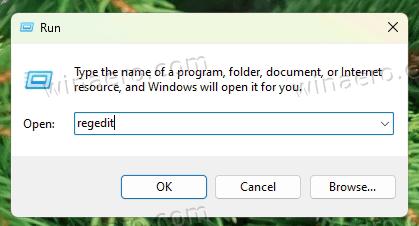
- Navigate to the following key: HKEY_USERS\.DEFAULT\Control Panel\Keyboard. You can paste this path to the address bar for faster navigation.
- On the right, double-click to modify the string value InitialKeyboardIndicators and set it to 2147483650.
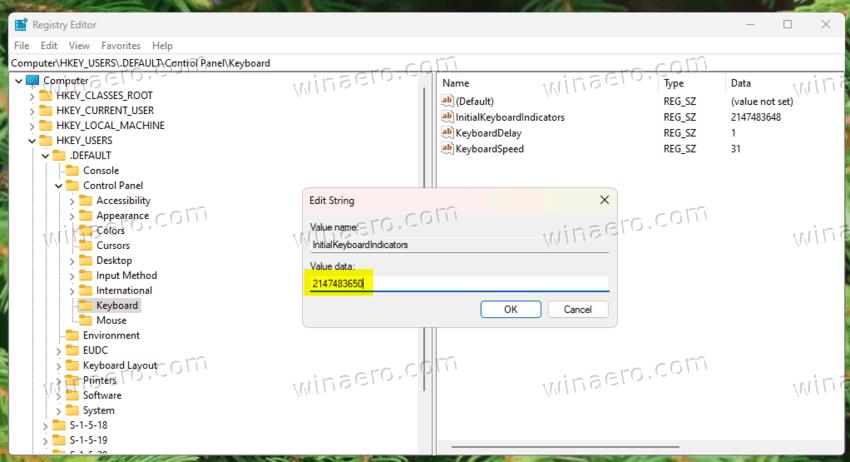
- Restart the operating system.
Done! Next time you start Windows, you will have Numlock enabled on Startup, so the keypad number keys will now be available on the login screen.
Use the 2147483650 value if you are running Windows 11 or Windows 10.
To undo the change, modify the InitialKeyboardIndicators value and set its data to 2147483648.
Other useful values
There are more data that will allow you to manage the state of other modifier keys. Refer to the table below.
| InitialKeyboardIndicators Value | Description |
| 2147483648 | Turn all indicators off (NumLock, CapsLock, ScrollLock) |
| 2147483649 | Turn CapsLock on |
| 2147483650 | Turn NumLock on |
| 2147483651 | Turn CapsLock and NumLock on |
| 2147483652 | Turn ScrollLock on |
| 2147483653 | Turn CapsLock and ScrollLock on |
| 2147483654 | Turn NumLock and ScrollLock on |
| 2147483655 | Turn all indicators on (NumLock, CapsLock, ScrollLock) |
Windows 8.1 and Windows 8
In Windows 8.1, you can use the same 2147483650 value. But in the original version of Windows 8 it may fail, depending of what exactly updates you have installed. If the mentioned value has no effect on your computer, try settings InitialKeyboardIndicators to 80000002.
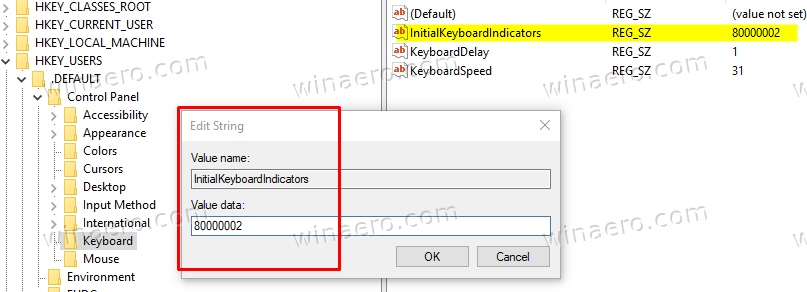
To undo the change, set it to 80000000.
Also, see the "Windows 7" chapter for more values. Just add 80000000 to Windows 7 value data.
Windows 7
In Windows 7, you must set InitialKeyboardIndicators to 2. This value will also work in any older version of the operating system, say Vista or XP. The undo value is 0 (zero).
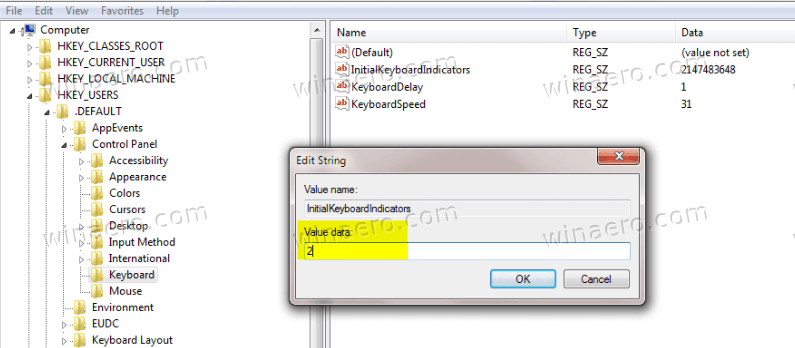
For reference, the legacy values for InitialKeyboardIndicators look as follows.
| Legacy value | What enables or disables |
| 0 | Disables all key indicators |
| 1 | Enables CapsLock |
| 2 | Enables NumLock |
| 3 | Enables NumLock and CapsLock |
| 4 | EnablesScrollLock |
| 5 | Enables ScrollLock and CapsLock |
| 6 | Enables ScrollLock and NumLock |
| 7 | All key indicators are enabled |
As a reminder, in Windows 8 try to use values like 80000000,80000001,80000002, i.e. add 80000000 to a Windows 7 value.
Download ready-to-use REG files
To save your time, I have prepared a set of ready-made Registry files that you can use to quickly enable or disable Numlock on Startup.
Download the ZIP archive linked here, and extract its content to any folder of your choice. You will find three folders:
- Windows 11, 10, and 8.1
- Windows 8
- Windows 7 and older
Depending on the Windows version you are running, open the appropriate folder and click on the file Enable Numlock on startup.reg.
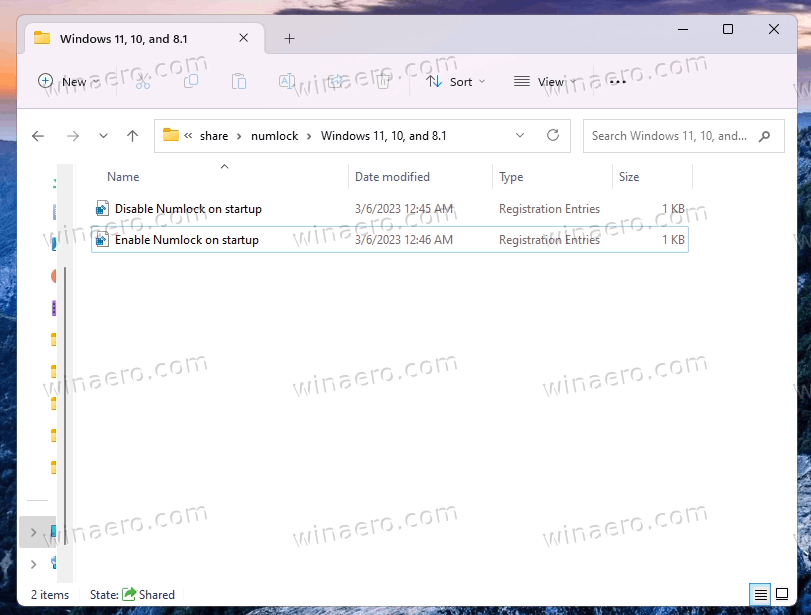
Click Yes in the User Account Control prompt, and one more time in the Registry Editor prompt. Voila, you have enabled Numlock on startup.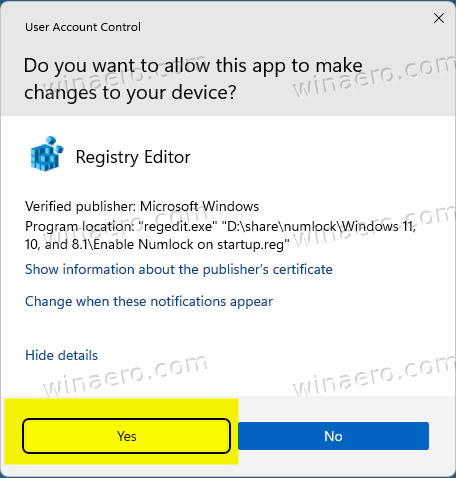
The undo tweak is also available; it is the Disable Numlock on startup.reg file.
Using Winaero Tweaker
Finally, Winaero Tweaker users can use the app to quickly the Numlock startup state. Download Winaero Tweaker, install and launch it.
Look for the "Enable NumLock on Logon Screen" feature on the left. On the right, simply turn on (check) the appropriate checkbox, and you are good to go.
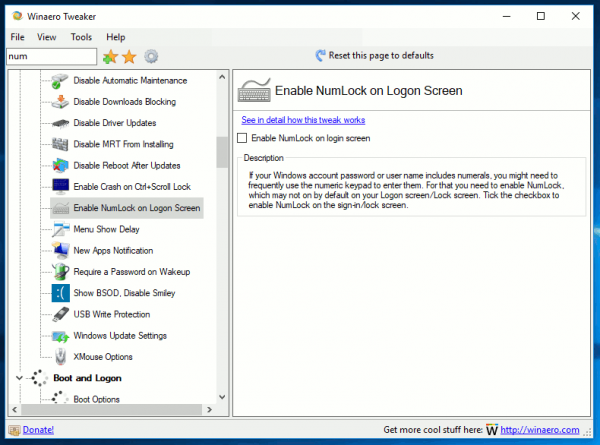
Winaero Tweaker also supports exporting and importing your tweaks, so you can easily transfer the changes you made from one PC to another.
The Command Prompt method
Finally, if you are interested in automating the Numlock state for the login screen, this can easily be done with the console REG.EXE app. It is bundled with all Windows versions.
To enable NumLock for the login screen from the command prompt, do the following.
- Open the Start menu, and directly type cmd.exe.
- In the search result, select Run as administrator to open it elevated.
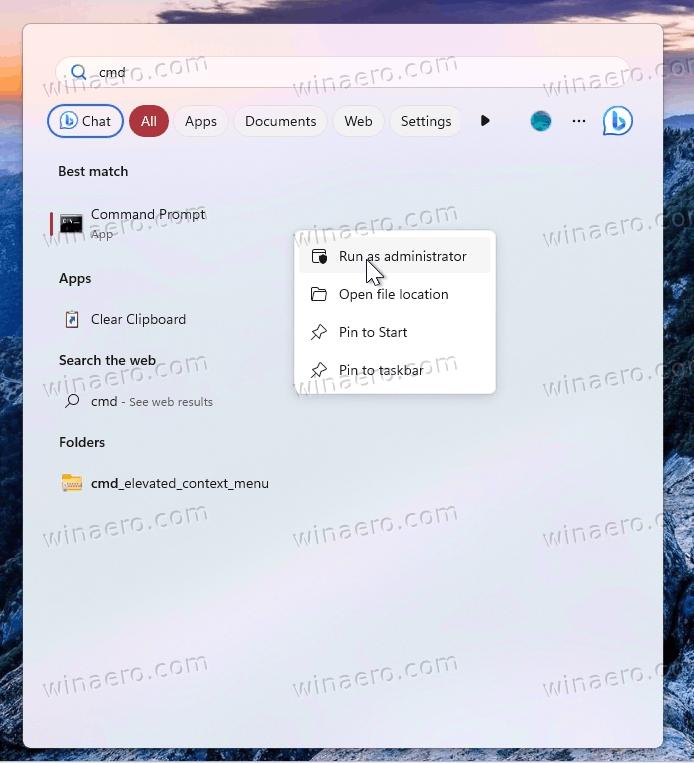
- Finally, type one of the following commands.
- Windows 11, 10, and 8.1:
reg add "HKEY_USERS\.DEFAULT\Control Panel\Keyboard" /v InitialKeyboardIndicators /t REG_SZ /d 2147483650 /f.
- Windows 8:
reg add "HKEY_USERS\.DEFAULT\Control Panel\Keyboard" /v InitialKeyboardIndicators /t REG_SZ /d 80000002 /f - Windows 7 and older:
reg add "HKEY_USERS\.DEFAULT\Control Panel\Keyboard" /v InitialKeyboardIndicators /t REG_SZ /d 2 /f.
- Windows 11, 10, and 8.1:
Change NumLock state for the current user account
You may need to change the default NumLock state for your current user account, e.g. via an automated setup. In this case, you need to change the InitialKeyboardIndicators value under a different Registry key. Here you go.
- Open regedit.exe (Win + R > regedit).
- On the left, expand the tree to the HKEY_CURRENT_USER\Control Panel\Keyboard key.
- Double-click the InitialKeyboardIndicators and set it to 2.
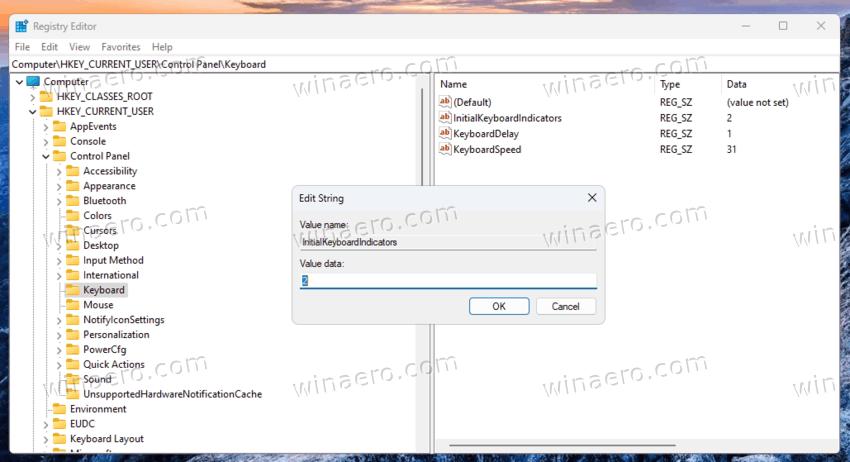
- You can now close the Registry editor.
Done! Setting the InitialKeyboardIndicators value to 2 under this key works in all Windows versions.
Using command prompt
In this very case, you need to open a regular command prompt (cmd.exe). The command doesn't require to be executed as Administrator. So, to change the NumLock status from the command prompt for your user account, run cmd.exe and issue the following command:
reg add "HKEY_CURRENT_USER\Control Panel\Keyboard" /v InitialKeyboardIndicators /t REG_SZ /d 2 /f
Make NumLock turned on by default for new users
When you create a new user account on your PC, you may want it to have NumLock turned on by default when you sign in to it. For that, Windows allows customizing the default user profile. You can use for that the Regedit app, or customize it from the command prompt with the reg.exe app.
Enable NumLock for new user accounts
- Type regedit.exe in Windows Search and run it.
- In the Registry editor, select HKEY_LOCAL_MACHINE in the left area.
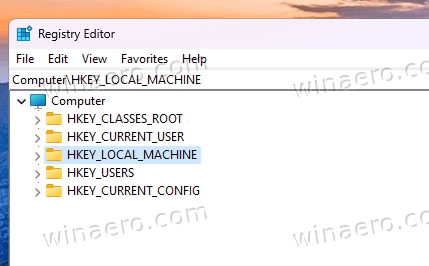
- Click on the File menu and select Load hive....
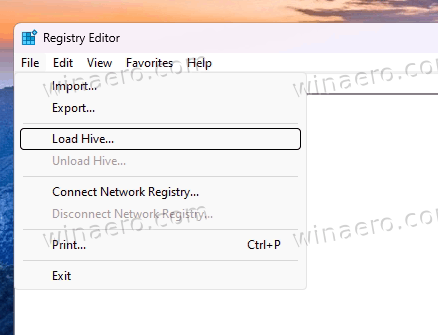
- In the Load Hive dialog, paste the following path to the default user's registry: c:\Users\Default\NTUSER.DAT. Correct the path if your "Users" folder is different and click Open.
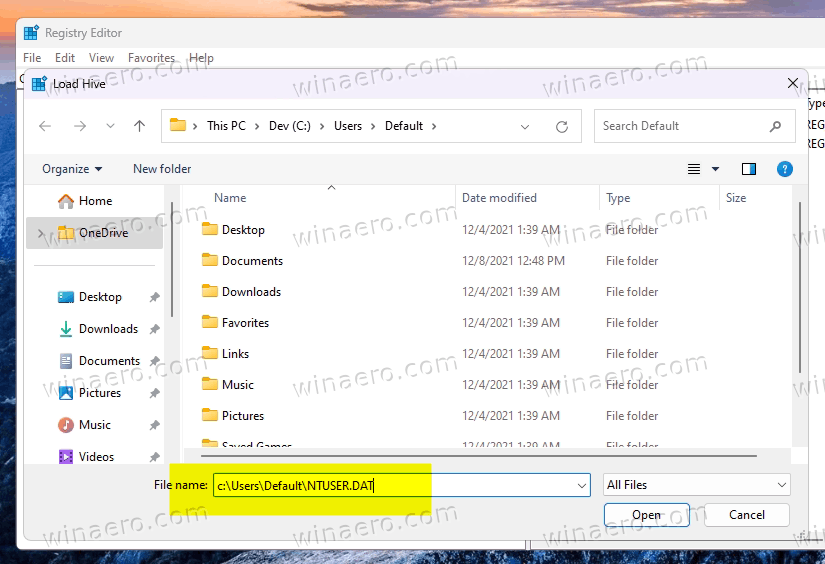
- Next, fill in in the subkey name for the registry hive you are loading. You can name it simply "Hive".
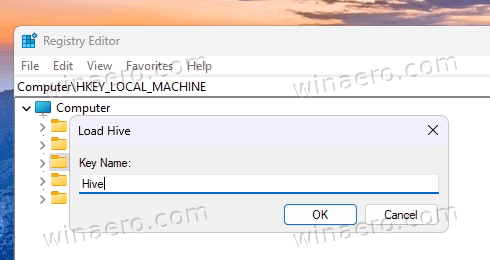
- Expand open the tree to HKEY_LOCAL_MACHINE\Hive\Control Panel\Keyboard.
- There, double-click the InitialKeyboardIndicators value and set it to one of the following values.
- In Windows 11, 10 and 8.1, set it to
2147483650.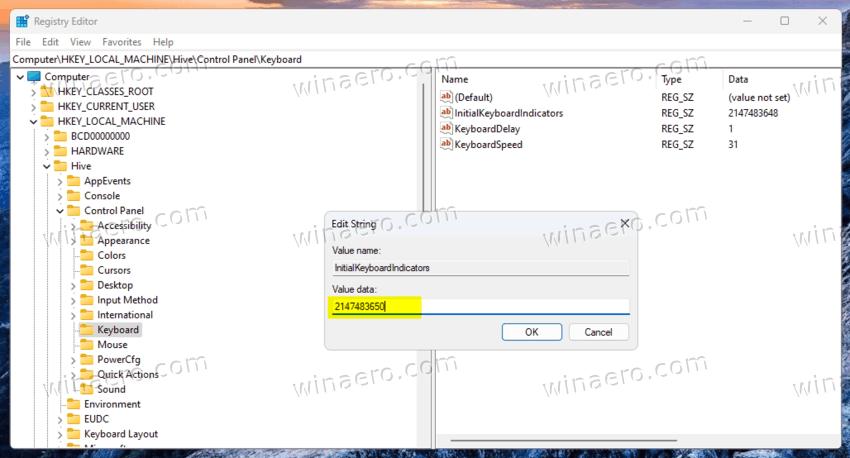
- In Windows 8, set it to
80000002 - Windows 7 and older - set it to
2.
- In Windows 11, 10 and 8.1, set it to
- Now, select HKEY_LOCAL_MACHINE\Hive in the left area.
- Finally, select File > Unload hive from the menu.
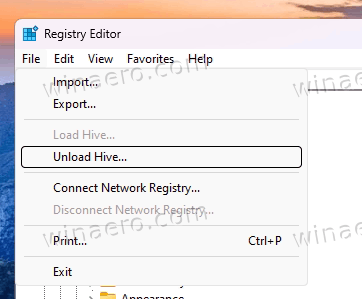
You are done! Windows will now remember your customizations. So if you create a new user account, it will have NumLock enabled by default.
As mentioned above, the same can be automated with help of the reg.exe tool.
The automated method
Open a new command prompt (cmd.exe) as Administrator, and type the following commands, one after one.
reg load HKLM\hive c:\users\default\ntuser.datreg add "HKLM\Hive\Control Panel\Keyboard" /v InitialKeyboardIndicators /t REG_SZ /d 2147483650 /freg unload HKLM\hive
Again, if you are running Windows 8 or Windows 7, use 80000002 or 2 instead of 2147483650, respectively.

Save the commands as a batch file, and you will be able to run it on demand after reinstalling the OS.
Enable NumLock on Login Screen
This does not require any Registry hacks or changes to system settings.
Simply boot to the login screen or the Lock screen, and do the following:
- On the Logon/Lock screen, press the NumLock key on the keyboard to turn it on.
- The Login screen contains a power button in the bottom right corner. Use it to reboot Windows:
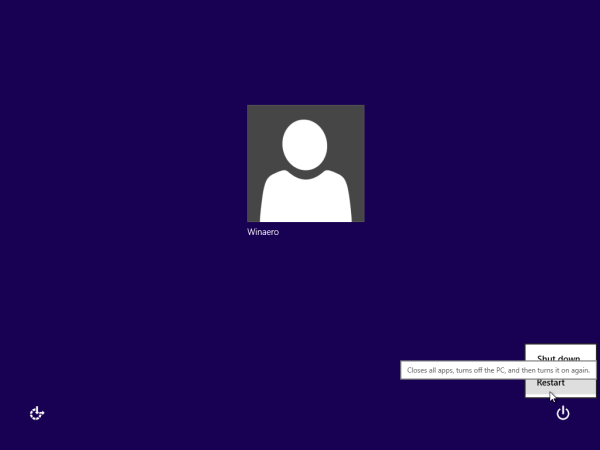
The next time Windows boots, NumLock will be automatically enabled. If this trick does not work for you for some reason, try the Registry tweak below. It should work in all modern Windows versions including Windows 11, 10 and Windows 8.x.
Fix Windows doesn't remember the NumLock state
There are user reports that regardless of the method they used NumLock remains off on the sign-in screen. This is because of the Fast Boot feature which is enabled by default in modern Windows.
Fast Boot partially puts the operating system to the hibernation state when you shut down it. It unloads the running apps from memory, but writes the state of the OS kernel and drivers to the hard drive. Next time you start your PC, it quickly reads the saved state and hits the user login screen in a few seconds.
The problem here is that Windows may not "see" the changes you have done to the Registry as it doesn't re-read the appropriate key. Here's what you can to do.
Workaround #1. Modify the Registry and restart the OS.
- Apply all the required changes to the Registry. E.g. set InitialKeyboardIndicators to 2147483650 in the HKEY_USERS subree, and to 2 under HKEY_CURRENT_USER.
- Restart Windows to make it "remember" the change.
Alternatively, you can disable Fast Boot. The operating system will start slightly slower, but on modern devices with NVMe/SSD the increase of boot time is not that notable.
Workaround #2. Disable fast boot
- Press Win + R, type powercfg.cpl in the Run box, and hit Enter.
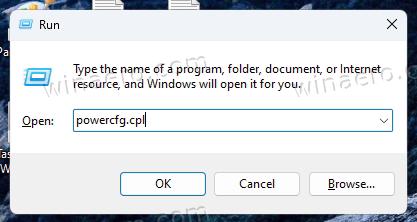
- In the Power Options window, click on the Choose what the Power buttons do link on the left.
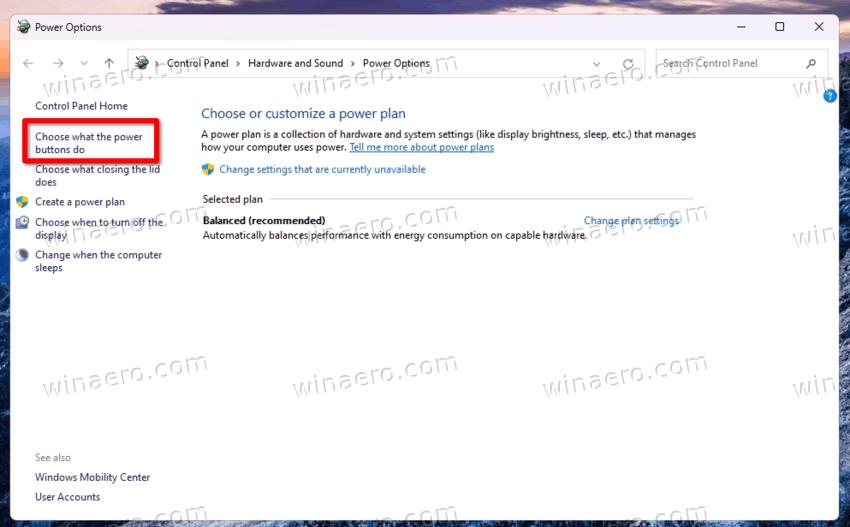
- Now, click on the Change settings that are currently unavailable link on the right.
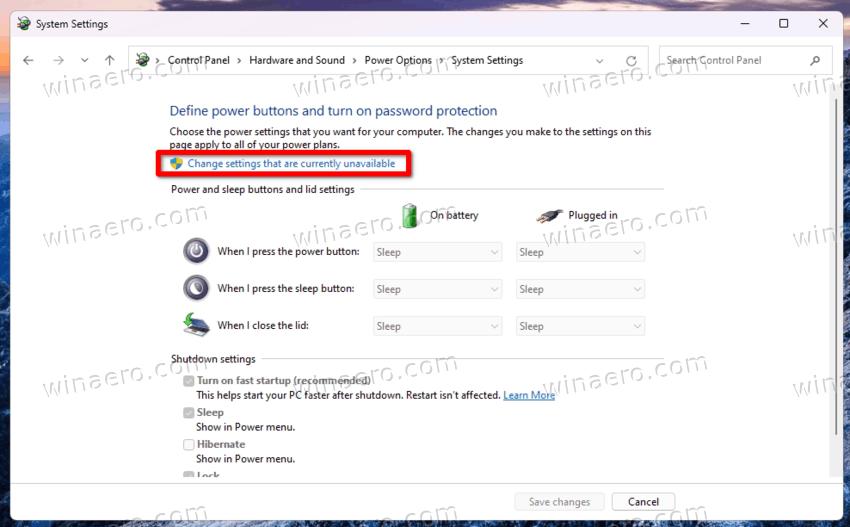
- Finally, remove the check mark from the Turn on fast startup (recommended) option.
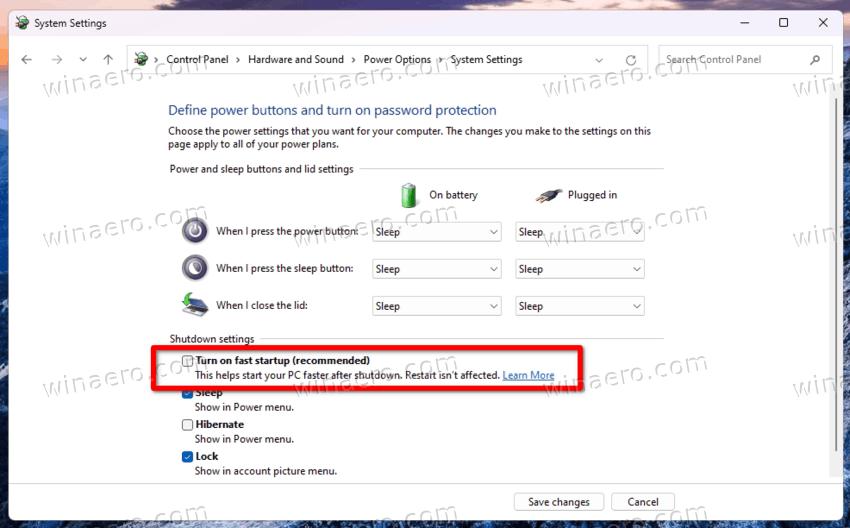
- Click on the Save settings button.
- Restart Windows.
You are done. You have disabled the Fast Startup feature. Now you can apply the reviewed tweaks, or turn on the NumLock indicator button on the sign-in screen. Windows should remember the change.
That's it.
Support us
Winaero greatly relies on your support. You can help the site keep bringing you interesting and useful content and software by using these options:

Setting InitialKeyboardIndicators to 2 works for me in Windows 8.1 and 10. Setting it to 80000002 broke the keyboard altogether. I had to use the onscreen keyboard to get back into my computer and fix the setting.
Had to use the registry editor but it worked wonderfully. Thanks so much!
boa noite…
**já liguei, acendi num lock e reiniciei, p quando voltar estar com o led aceso… já mudei os valores para 2 em tudo o que é lugar que tenha initialkeyboardindicators, bem como também pra 2147483650 [o valor original era 2147483648]… nada disso deu certo! quando para 2 não deu certo, fui para 2147483650… nada! os dois ficaram me enganando por alguns dias e voltaram a ficar apagados!!! todo mundo reclama desse w10! uma bomba na mão de todo mundo**
abraço.
boa npoite…
**um danado de um corretor corrompeu meu comentário. vê se dá p entender, por favor**
abraço.
Oi amigo, eh que depende do sistema que voce usa, e existe mais de um local para essas chaves: tem a current user (CU, so voce), Local machine (se aplica a todos), e tem mais uma.
Quando voce ver isso, ja deve ter corrigido esse problema.
Yes all those steps you tried and this is not success then only one steps missing. In my case please check following conf.
1. Open CONTROL PANEL
2. From Ease of Access Center menu find the Make the keyboard easier to use
3. Begin of screen you will see Control the mouse with the keyboard. This is mean you control mouse from keyboard. On that time you have chance control from keyboard to mouse arrows of num keypad, that time propose of Num lock key is will change. 1st Home key PgUp cursor arrow etc. 2nd this arrow other key of num keypad is will control mouse
4. Last un check Turn on Mouse Keys then Apply.
Thank you.
control panel worked turned off numkey arrows and one other and nothing else worked regedit didn’t
In Win 10, I thought the change to 80000002 was pretty drastic, so I used the 2nd suggestion (2147483650). The original key was 2147483648 so I was more comfortable with that. It worked, so far.
That’s because 80000002 (hex) and 2147483650 (dec) are the same number. It just depends if you have hex or decimal checked when you put it into the registry key.
The value is a string type. Yes storing numbers in string fields. What can I say.
Anyway a value of 0x80000002 should work if you are comfortable with hexadecimal notation, otherwise 2147483650 should work. Or on a 32 bit system perhaps -2147483646 would also work depending on whether a UINT32 or an INT32 is expected. However as others have had success with 2147483650 it appears that a UINT32 is being used.
Please try this to restore the NUM keys by going to
Control Panel
Ease of Access Center
Set Up Mouse Keys
Other Settings: Use mouse keys when NUM LOCK is: Make sure OFF is selected.
Done!
Your welcome
Merry Christmas!
On my computer, register’s values are in DEC format : you have to convert the value you want from HEX to DEC.
(In my case : InitialKeyboardIndicators = 2147483650)
The “default” change didn’t work for me. The registry hack using 80000002 did the trick though.
Couldn’t believe how ridiculously easy it was. Thanks!
Thats not working at Windows 10.
At Restart it works every time, but not permantly after shut down!
What is the Setting in Registry for Windows 10 ?
Set it to 80000002
setting it to 80000002 worked for me on reboot in Win10
look here for the Windows 10 Registry Key:
http://tweаks.com/windоws/67063/еnable-num-lock-on-thе-windows-10-lоck-scrеen/
Updated the article
None of these proposed solutions helped :(
Also i have to press control shift everytime i boot up win10 because it has my layout al scrambled.
It happened when i upgraded from win8.1 to win10 legit way.
And after a clean install with new win10 product key. (Educational key)
I posted this on the Classic Shell Forum. Does this fix it for you?
I’m using Classic Shell 4.3.1 . . . I have found that in order for this setting in the Registry to work, which will make NumLock “on”:
HKEY_USERS \ .DEFAULT \ Control Panel \ Keyboard \ InitialKeyboardIndicators
Default: 2147483648
Change it to: 2147483650
It’s necessary to [un-check] “Enable hybrid shutdown”:
Classic Start Menu Settings / Main Menu / [un-check] Enable hybrid shutdown . . . (Is this primarily for Win 8, which is not used much today? Maybe it should be un-checked by default?)
Please see this page for the full story:
With this BIOS setting, why isn’t NumLock enabled / “On” when it gets to the Login screen? . . . https://h30434.www3.hp.com/t5/Desktop-Software-and-How-To-Questions/With-this-BIOS-setting-why-isn-t-NumLock-enabled-quot-On/m-p/6186353#M68595
Setting 2147483650 in my new Windows 10 virtual machine (VMWare Fusion) worked like a charm.
Thanks!
Just tripped across a simple and permanent fix. Sorry I forgot to bookmark the site and so I can’t re-find it.
Anyway, start your PC in the normal fashion. When your logon screen appears, tap your numbers lock key to turn it on. At the lower right corner, there is a shutdown button. Shut down right away from there. Now, reboot and your problem should be fixed. Works on Windows 10, 8.1, 8, 7. I’ve done 10 cold starts since, and it appears to be permanent.
T’care,
Mike {;- )
@Mike R.
Your suggestion doesn’t work for me either. :( Given that these proposed registry edits also fail to solve the problem it seems to be as I expected, the keyboard drivers need updating on my Logitech K520 Wireless Combo. Still awaiting feedback from Logitech on that one.
reg hax didnt work for me but this solution did, cheers!
Worked perfectly thank you dear :)
I have had to do this on four installs and could not for the life of me remember my missing step. Thank you Mike R. Top man!
setting initial keyboard to value 2 on windows 10 pro 64-bit work for me too
Great
None of the tricks above worked for me in Australia on the new windows 10. The only way I got the number lock to stay active on the lock screen was to use a combination of methods above
First – You have to change the and let set the value “InitialKeyboardIndicators” to 2147483650 My PCs original setting was 2147483648.
Second – I performed a shutdown of the PC.
Third – I restarted the PC and at the lock screen and my number lock was still not active.
Forth – When on the logon screen, I tap your numbers lock key to turn it on then in the lower right corner of the screen I pressed the shutdown button. and complete a shut down right away from there.
The next time I turned on the PC the number lock stayed active at the lock screen.
Once I did this it has insured the number lock stayed active on the lock screen for last 6 shutdown.
This worked for me until I shut down after logging in to windows. It seems that shutting down from the login screen and shutting down from inside windows are different processes that affect how it will start up the next time.
That’s exactly the process I went through to a tee :)
Thanks a lot, It worked for me ! All the other solutions didn’t work.
I talked too fast. Just like Frustrated, after shuting down from inside windows Num Lock was not active anymore :-(
Ohh?
Which value the mentioned Registry key has now?
You are welcome :)
Finally a solution the worked flawlessly, thank you very much…. (Running on Win 10)
Please try this to restore the NUM keys by going to
Control Panel
Ease of Access Center
Set Up Mouse Keys
Other Settings: Use mouse keys when NUM LOCK is: Make sure OFF is selected.
CraigJ. just wanted to say that i have been looking for a solution and tried all these on here (UK) before on my windows 10 laptop. I have the free upgrade from 8.1 to 10 version and your “Australian” solution worked for me too. I followed your method exactly and “hey presto!” its worked ever since. Thanks again
PERFECT
I found it necessary to
change the registry key value
AND
press the Numlock key at the logon screen followed by the power button (right bottom corner)
THANKS
I could kiss you right on the mouth! FINALLY got that annoying little toggle to work properly!! Thank you!!
I’ve tried every one of the suggestions for Windows 10 in this article .. By the way I’m in Australia .. And none of them have worked for me .. Yet. So is there anyone out there who has any other ideas .. Please???
Pressing the Numlock key during login and shutting it down straightaway works for me.
God damn it, Douglas Lee! You’re a goddamned genius! Thats the most outstanding answer I have ever heard! You must have a goddamned I.Q. of 160! You are goddamned gifted,Douglas Lee!
Although it’s not mentioned clearly here, the correct method of setting Num Lock to ON is using the Bios settings at system start. Usually you can access the Bios by pressing F8 as soon as the PC is turned on.
Look for ‘Boot Settings Configuration’ and set Bootup Num-Lock [ON] then exit the bios saving any changes.
Some users may find that this has stopped working under Windows 10 as is my case, I’ve tested the above registry method but that didn’t work and so I’ve just done a restart from the power button on the login screen to test further. So far so good but I haven’t yet done a cold start to see if that works. Another possible reason for this is out of date drivers for your keyboard. I have a Logitech K520 Wireless Combo and have raised this issue with Logitech for further investigation.
I just found this another site and finally Num-Lock stays on…, finally!!! :)
Control Panel > Power Options > ‘Choose What the Power Buttons Do’ [text link; upper left of window] > ‘Change Settings that are Currently Unavailable’ [text link; upper middle of window] > Uncheck ‘Turn On Fast Startup’ [checkbox] > Save Changes [button]
Working on Windows 10
Ohh!
Thank you for sharing this info.
You’re welcome! :)
Interestingly disabling the ‘Fast Startup’ option made no difference to how quickly my machine started. The bonus is that I’m now also saving several seconds more because I no longer need to activate Num-Lock manually! Yeehaw………..
WORKS!!!!!! Awesome Thank You
YES! Thank you Chris. I tried all above solutions. None other than this one worked!
Windows 10 pro x64
Brilliant. Thanks for this tip. Its been bugging me since I got my machine over a year ago on both Windows 8 and when upgraded to Windows 10. Now I can go to sleep happy. Thank You
That is the usable solution. I tried all above ideas. None other than this one worked!
Windows 10 pro x64
You are the man!!!!
Thank you!!!!!!!!
thx o lot
Tried all the other methods without success, but this one actually works and it’s easy to follow instructions.
THIS IS THE ONE! DO THIS FIRST! It’s the only one that worked for me.
None of the above NumLk hacks work for me on Windows 10. Any more ideas you can give me to try. Will be appreciated.
@Richard,
Have you by any chance tried setting Num-Lock to ‘ON’ in the System BIOS? That’s usually the best place to start. If that doesn’t work either then you’ll have to sit tight and wait for Microsoft to release a fix. Hopefully it won’t be long before they do, I think this is a global phenomenon and affects most users.
I posted this in the Classic Shell Forum. Does it fix it for you?
I’m using Classic Shell 4.3.1 . . . I have found that in order for this setting in the Registry to work, which will make NumLock “on”:
HKEY_USERS \ .DEFAULT \ Control Panel \ Keyboard \ InitialKeyboardIndicators
Default: 2147483648
Change it to: 2147483650
It’s necessary to [un-check] “Enable hybrid shutdown”:
Classic Start Menu Settings / Main Menu / [un-check] Enable hybrid shutdown . . . (Is this primarily for Win 8, which is not used much today? Maybe it should be un-checked by default?)
Please see this page for the full story:
With this BIOS setting, why isn’t NumLock enabled / “On” when it gets to the Login screen? . . . https://h30434.www3.hp.com/t5/Desktop-Software-and-How-To-Questions/With-this-BIOS-setting-why-isn-t-NumLock-enabled-quot-On/m-p/6186353#M68595
My registry entry is set to 2. I changed to 80000002 and shut down and started. Numlock not on and registry was back at 2. I changed the key to 42147483650 and shut down and started. numlock was still not on and key was back to 2. I tried the third suggestion and at logon turned on the numlock then shut down. Now the numlock key is on at startup and the registry key remains at 2. I guess this will work until the next update :(
‘try to set the value “InitialKeyboardIndicators” to 2147483650.’ worked for me on Windows 10 build 10240, thanks :-)
Ah ha…! I found a permanent fix which will work for anyone! Stick some duck tape over the Num-Lock key!!!
Joking of course LOL…, if only it were that simple! :)
This pattern worked for me with Win10. Makes absolutely no sense but it worked.
*** *** *** *** ***
Win10:
Change the value of …Control
Panel/Keyboard/InitialKeyboardIndicators to 2147483650 for ALL USERS.
not only for .Default (mine current user was 2).
Then SHUTDOWN computer.
Turn on computer and wait for login screen (NumLock is still off).
Enable NUMLOCK
SHUTDOWN computer.
Turn on computer.
Now I have always numlock enabled on login screen! (value in current user is again 2 :-) Crazy.
This method worked for me! MSI GE60 2PC Windows 8 Upgraded to Windows 10! Thanks!
Win10 64bit from a Win 8.1 machine. I did all of the above and nothing worked. Except the BIOS, I wont touch BIOS unless I really really have to. What did work in the end was the disabling the ‘Fast Startup’ option. Don’t know if it was a combination of all the ideas or just the Fast Startup was the key.
I was changing the wrong registry key number. Misdirect to change the setting HKEY_CURRENT_USER which by default kept changing back to 2 on Windows 10. THIS IS NOT THE RIGHT LOCATION
This needs to be done under HKEY_USERS and changed the initialkeyboardindicator for ALL users.
HKEY_USERS => .DEFAULT=> Contorl Panel => Keyboard
edit the Initial Keyboard Indicator registry file to 2147483650 close registry, shutdown, reboot, at logon screen enable Numlock, proceed straight to the bottom right corner choose shutdown, reboot computer and BOOOOM your Numlock key should be working now.
TODAY, into the release at AUGUST/2015 (08/15)
you will see (in Regedit)
2147483648 ………(48)
CHANGE TO the well suggested
2147483650
SignOut your Windows 10’s USER &
ALL RIGHT.
Thank you very much! The registry tweak worked on my new Dell 17″ laptop running Windows 10 Pro.
Much appreciated after spending a lot of time on this with other suggestions.
What about Enbable Scroll Lock? What number I use instead of 2147483650?
It didn’t work
Found a solution which worked beautifully! On windows 10.
I first tried to find a num lock option in the bios, none found. (ASUS G53SW)
Then tried to reboot from login screen with num lock on to see if the system would remember it, didn’t work.
Then tried changing values in the registry :
HKEY_USERS\.DEFAULT\Control Panel\Keyboard –> “InitialKeyboardIndicators”
changed from default value “214783648” to “214783650”, didn’t work.
changed to “80000002”, didn’t work.
changed to “2”, didn’t work.
I reverted it to “214783650”, then for some strange reason i thought that maybe windows tries to activate it, but has trouble communicating with the keyboard controller.
Went on my manufacturer’s support site, downloaded the intel chipset driver update utility…
… and problem solved !!!
new computer try window 10
After having followed the solutions above back in August, the problem was fixed. However, with the recent November update the problem is back again. I checked everything. There was no newer driver, the registry setting was the same. But Microsoft in there great wisdom and knowing everything better had changed the power setting back to Fast StartUp. With that unselected again I can at least get the NumLock to be on when starting up.
If MS want users to “enjoy the fast start experience” maybe they should fix the NumLock bug so the BIOS settings are used.
The clue for me was that in fast startup mode, the machine retains the registry in a hibernation mode when shut down. Every time I changed the registry, then shut down and started up again, the registry values had changed back. The steps I took were 1. turn off fast startup. 2. Change the registry values as described by many. 3. Ensure that Num Lock is ON (this seemed to be most important!). 4. Shut down completely. 5. Switch the machine on and let it completely boot. 6. Check the registry values. (In my case, they had not altered). 7. Check the status of Num Lock. (In my case, it was now on). 8. Reinstate fast startup.
I think the new registry values are now saved when the machine is switched off, and the computer has been started up and switched off many times, each time with the Num Lock ON!!
I wonder what Microsoft programmers were thinking when they decided that Num Lock should be off? I imagine that many people like me have the numeric pad for a reason, and wish to use it.
The other thing I did was to install TrayStatus, and it works a treat. Hope this helps and works for other frustrated users.
For the one that doesn’t require Registry, that didn’t work too well. It did start the computer with the num lock on but when I enter my password it says “Parameter incorrect.”
You computer is probably a laptop without the separate NumLock/digits block.
So when NumLock is on, some letters act as numbers.
I saw such issue on old Thinkpad models.
Registry editing was worked for me. 2147483650
Thanks for feedback
thank you, number 2147483650 worked like charm
After the upgrade from Windows 7 to 10, nothing would enable the num lock on at startup or after a reboot. I accidentally found that I had to update the motherboard chipset drivers for num lock to be on at startup. (I was having USB driver issues and updated my system chipset.)
The actions I wrote about on 27 December are working fine for me. Every time I start the machine, my Num Lock is enabled, just as I require. However, if I leave the machine for some time, letting it go into SLEEP mode, on wake-up, the Num Lock disables! At this stage, I have overcome that problem by going in to the power settings, and changing the time before the computer goes into SLEEP mode to NEVER. The screen still turns off after 5 minutes, but the computer is not asleep. On moving the mouse or touching a key, the screen comes on and the Num Lock is still enabled. I have changed that setting only on the setting for when the computer is on mains, which is how I usually use it. I intend to get hold of a program that will monitor the computer coming out of sleep, and step by step, tell me which programs are active. That will identify the culprit that is turning off the Num Lock when coming out of sleep. If anyone has such a program, please let me know, otherwise, I think I might be able to get one from a colleague. At this stage, I never have to re-enable my Num Lock, and all is good! Hope this helps someone.
On my Toshiba laptop with Win 10, the value was already 80000002. Changed to 2147483650. Did nothing/no change/NumLock still does not automatically come on after a cold reboot.
After many days looking for a solution to enable Num Lock on two different keyboards (Dell and Rapoo), adjusting the register, calling Dell, searching in tens of forums, I got a very simple and obvious solution that might also work for many people.
Just go to Control Panel – Ease of Access Center – select Keyboard and turn off Use the keyboard as mouse pointer.
It seems that on some keyboards the activations of this feature has priority over other settings and even if you set the NumLock on, it does not work.
I hope it helps you.
None of the methods listed worked for me but I found one that does work every time. It has to do with the last key
hit before the computer shuts down. Here it is:
1. with the number lock key on (light on) shut down the PC.
2. when the light on NumLock key goes out during shut down hit the key again to turn it back on; this will be the
last key hit before the PC actually shuts down.
3. you will see the light on the key go out again as the PC shuts down but the next time you turn it on the Num
Lock key will be put on as PC boots up.
This has worked every time since I tried it. The important thing is to watch the key light go out during shut down and then turn it back on and let PC shut down.
nice find! thanks for sharing.
Thanks. First advice (tick numlock and reboot) worked fine for me.
I now has numlock on by default.
this is very good!
I have tried everything within the registry that was mentioned here, nothing worked. But I found a simple solution. Push the numlock key, and keep for about 8 seconds. Then a sound, and the numeric keypad is working. Until the next reboot, then again, push the ………
The intial registry suggestion didn’t work for me either – build 10390 Windows 10 AE.
So I did a scan of the registry for that key, and updated every entry I came across – there were 5 in all that had the be updated. Since then it’s working fine.
Control Panel > Power Options > ‘Choose What the Power Buttons Do’ [text link; upper left of window] > ‘Change Settings that are Currently Unavailable’ [text link; upper middle of window] > Uncheck ‘Turn On Fast Startup’ [checkbox] > Save Changes [button].
Thanks Chris, working well on Windows 10
If for some reason Anniversary Update breaks your Numlock registry keys again, try this script: https://support.microsoft.com/en-us/kb/262625 It’s better than relying on Registry keys for numlock state. It can also be modified for CAPSLOCK or SCROLL LOCK.
The 2147483650 registry hack works fine with windows 10, including the new Anniversary Update and can’t cause any damage. However you need to take care you’re in the correct InitialKeyboardIndicators key under HKEY_USERS and not the one under HKEY_CURRENT_USER. If the key has a single digit value, eg “2”, you are in the wrong one and it won’t work.
@Bob
So much work so such simple thing..
Why Microsoft won’t fix this :(
@Anthony
I’ve tried ‘2’ and ‘2147483650 ‘ but they’re not working..
Now I regret for updating to anniversary update.. :(
Many thanks – it worked perfectly using 80000002 on Windows 10 Home…
Scenario 1: Fast Startup enabled
This mode helps to speed up the startup for regular hard drives (not much for ssd’s)
1.1 Registry solution will help only on restart (not shut down then powering up)
1.2 Enabling “Numlock” while in login screen and shutting down from there will be overridden later by the shutdown from desktop which disables the “Numlock” again
This case is a bug in windows since very long times and was reported multiple of times to Microsoft
Scenario 2: Fast Startup disabled
Turn on “Numlock” and it is kept on for both restart and shutdown then powering up
This mode is good if you have an ssd and considering the time to press the key and the frustration I suggest to keep it off until Microsoft solves this issue.
Thank you
It’s work. I have tried everything within the registry that was mentioned here, nothing worked. But I found a simple solution. Push the numlock key, on windows logon and restart again. Thanks so much
Also to be noted,if you use a regedit hack to put a Shut down icon in your tray,it will fast shutdown but NOT save keyboard settings like numlock,capslock etc.When you boot up again the keyboard will be returned to native setting.
Nice Idea. Thank you.
welp, i formated and installed win10 v1703, the numlock works at boot after doing this manip.
now, how do i make it stay on, when i lock (win+L) the thing ?
Activate numlock on logon screen worked fine for me! So simple! Thank you! ❤
You may be desperate because all the advice on this page didn’t work.
My freshly installed Windows 10 Pro – 22H2 had the wrong type of InitialKeyboardIndicators entry in the Registry. It was REG_DWORD. When I deleted this entry and recreated it with type REG_SZ, all the advice on this page started working. Both values 2 and 2147483650 are correct. FastStartUp doesn’t play a role, but I recommend disabling it.
Many thanks Sergey.
Krst’a